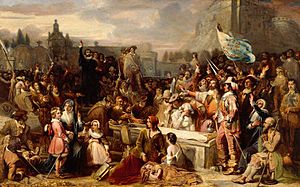Battle of Newburn facts for kids
Quick facts for kids Battle of Newburn |
|||||||
|---|---|---|---|---|---|---|---|
| Part of Second Bishops' War | |||||||
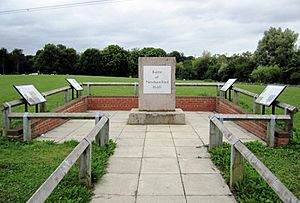 Monument marking the site of the Battle of Newburn |
|||||||
|
|||||||
| Belligerents | |||||||
| Commanders and leaders | |||||||
| Strength | |||||||
| 20,000 | 5,000 maximum | ||||||
| Casualties and losses | |||||||
| 300 | 300 | ||||||
The Battle of Newburn, also called the Battle of Newburn Ford, happened on 28 August 1640. It was a key event during the Second Bishops' War. This battle took place in Newburn, a small village near Newcastle, right at a crossing point (ford) over the River Tyne.
A large Scottish army, known as the Covenanters, had about 20,000 soldiers. They were led by Alexander Leslie. They fought against an English army of about 5,000 soldiers, led by Lord Conway. The Scots won this battle, which was the most important fight of the war. Their victory allowed them to take control of Newcastle. This city was very important because it supplied most of London's coal.
After the battle, the Treaty of Ripon was signed on 26 October. This agreement let the Scots stay in charge of large parts of northern England. The English also had to pay them £850 every day. These payments continued until August 1641, when the Treaty of London was signed. To get money for these payments, King Charles I had to call Parliament back together. This meeting of Parliament was a big step towards the First English Civil War, which started in August 1642.
Contents
Why Did the Battle of Newburn Happen?
Religious Differences in the 1600s
The Protestant Reformation changed how churches were run. In Scotland, the Church of Scotland, or 'kirk', became Presbyterian. This meant it was led by Elders chosen by church members. In England, the church was Episcopalian, led by bishops appointed by the king.
In 1584, bishops were forced upon the Scottish kirk, even though many Scots didn't want them. These bishops also sat in the Scottish Parliament. They usually supported the king's decisions. So, arguments about bishops were about both religion and politics.
Most Scots, whether they supported the Covenanters or the Royalists, believed a king was chosen by God. But they disagreed on how a 'well-ordered' kingdom should work. They also argued about who should have the final say in church matters. Royalists usually thought the king had more power. But people's reasons for choosing sides were often complex. For example, Montrose fought for the Covenanters in 1639 and 1640. Later, he became a Royalist. Changing sides was common during this time.
King James and Charles I's Plans
When James VI and I became King of England in 1603, he wanted to unite the churches of Scotland and England. He saw this as the first step to creating one strong country. However, the two churches had very different beliefs. Even Scottish bishops strongly disagreed with many practices of the Church of England.
Later, Charles I tried to make changes to the Scottish kirk. Many Scots were very unhappy about this. On 28 February 1638, they signed the National Covenant. This was a promise to oppose any changes to their church. Important people, including Argyll and six members of the Scottish Privy Council, signed it. In December, bishops were removed from the kirk.
The First Bishops' War
King Charles tried to show his power, which led to the First Bishops' War in 1639. The Covenanters beat the Royalist forces in Aberdeenshire. This helped them gain full control of Scotland. The English army was not well-organized and couldn't match the more experienced Scots.
The two sides signed the Treaty of Berwick in June. But both sides saw it as a chance to get stronger. In April 1640, Charles called Parliament together for the first time in eleven years. However, Parliament refused to approve new taxes unless the king made some agreements. So, Charles closed Parliament after only three weeks.
Despite this, Charles decided to go ahead with his plans. He was supported by his trusted advisor, Earl of Strafford. Just like in 1639, Charles planned a three-part attack. An Irish army would attack from the west. Another force would land by sea in the north. And an English army would attack from the south.
Again, the first two parts of his plan failed. His English troops were mostly local soldiers (militia) from the south. They were poorly equipped, not paid, and didn't want to fight. As they marched north, they didn't have enough supplies. They stole from the areas they passed through, causing a lot of trouble. Some groups even killed officers they thought were Catholic, then ran away.
Lord Conway, who was in charge of the English forces in the north, focused on strengthening Berwick-upon-Tweed. This town was usually the starting point for invading England. On 17 August, Scottish cavalry led by Montrose crossed the River Tweed. The rest of Leslie's army, about 20,000 soldiers, followed. The Scots went around Berwick and headed for Newcastle-on-Tyne. Newcastle was the center of the coal trade with London, and a valuable place to control.
The Battle of Newburn
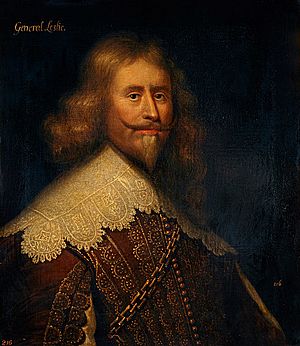
By 27 August, the Scottish army was getting close to Newcastle. To feed such a large army, Leslie had to either capture the city or retreat. Newcastle had strong defenses on the north side of the river. So, Leslie decided to cross the River Tyne at Newburn. Newburn was a small village six miles outside Newcastle. Crossing there would let him attack the city's weaker southern side.
On the evening of 28 August, Lord Conway arrived at Newburn. He had 1,000 cavalry (soldiers on horseback) and 2,000 infantry (soldiers on foot). They started building defenses on the south bank of the Tyne. Colonel Thomas Lunsford was in charge of this work. The next morning, Sir Jacob Astley joined them with another 2,000 infantry. But even with these extra troops, they were greatly outnumbered. Their positions around the ford were also very hard to defend.
The Scottish artillery commander, Alexander Hamilton, was a very skilled soldier. He placed his cannons on high ground to the north. This gave him a clear view to fire down on the English troops below. It also made it very hard for the English to shoot back at them.
Sir Jacob Astley, who had also fought in the Thirty Years' War, suggested moving back into the woods. This would have protected them from the Scottish cannons. But his advice was not taken. While waiting for low tide, Leslie asked Conway to let his army cross. He said they wanted to "deliver a petition to the king." Conway refused. Then, Conway received orders from Strafford to stop the Scots from crossing the ford. Looking back, retreating might have been a better choice. Taking Newcastle would take time, and English prisoners later said the Scots only had enough food for three days.
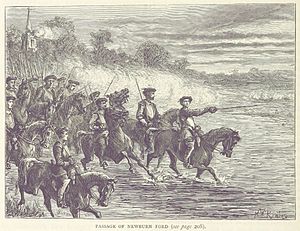
The battle began around 1:00 PM. A Scottish officer got too close to the ford and was shot. This started a cannon fight. Hamilton's cannons were much more numerous and in a better position. They quickly destroyed the English defenses around the ford. Despite Colonel Lunsford's efforts to rally his troops, they left their positions. This allowed the Scots to cross the river.
The English cavalry tried to counter-attack and were successful at first. But they were pushed back, and their commander, Henry Wilmot, was captured. Since his cavalry and infantry retreated in different directions, Conway could not reorganize his army. By early evening, the English were fully retreating towards Newcastle. Both sides had about 300 casualties (dead or wounded). Leslie told his troops not to chase the English. He was secretly in contact with John Pym and other members of Parliament who opposed the king. The Scots wanted to make it easier to agree on peace terms.
What Happened After the Battle?
Despite their victory, the Scots still needed to capture Newcastle. But to Leslie's surprise, when they arrived on 30 August, Conway had already pulled back to Durham. Some believe Conway didn't trust his poorly disciplined and rebellious troops. The morale of the rest of the English army then collapsed. This forced King Charles to make peace.
Under the Treaty of Ripon in October, the Scots were paid £850 per day. They were also allowed to stay in Northumberland and County Durham until final terms were agreed. To pay for this, King Charles had to call Parliament back. The Scots finally left Northern England after the Treaty of London in August 1641.
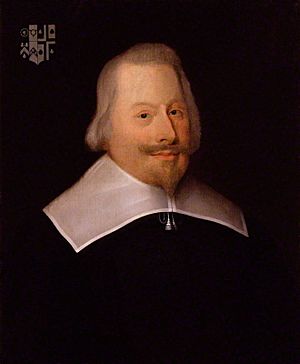
The defeat at Newburn forced Charles to call a Parliament he couldn't get rid of. However, the Irish Rebellion in 1641 was also very important. It contributed to the struggle that led to war in August 1642. Both Charles and Parliament agreed they needed to stop the revolt. But neither trusted the other to control the army raised for this purpose. This disagreement was the main reason for the First English Civil War.
The Scottish victory confirmed that the Covenanters controlled the government and the kirk. Scottish policy then focused on keeping these achievements. The Solemn League and Covenant in 1643 was signed because the Scots worried about what would happen to Scotland if Parliament lost. Like Charles, the Covenanters wanted political power by creating a united church of Scotland and England. But they wanted it to be Presbyterian, not Episcopalian.
However, their easy victories in the Bishops' Wars made them overestimate their military strength. They also thought they could force their religious goals on England. Unlike Scotland, Presbyterians were a minority in the Church of England. Also, many religious Independents were against any state church, especially one controlled by the Scots. One of the most famous opponents was Oliver Cromwell. He said he would fight rather than agree to such a plan.
Many political radicals, known as the Levellers, and much of the New Model Army, belonged to Independent churches. By 1646, the Scots and their English allies saw these Independents as a bigger threat than King Charles. The Scottish defeat in the Second English Civil War in 1648 led to Charles I's execution. Their failure to put his son back on the throne in the Third English Civil War in 1651 followed. After this, Scotland became part of the Commonwealth, a union made on English terms.
See also
 In Spanish: Batalla de Newburn para niños
In Spanish: Batalla de Newburn para niños


